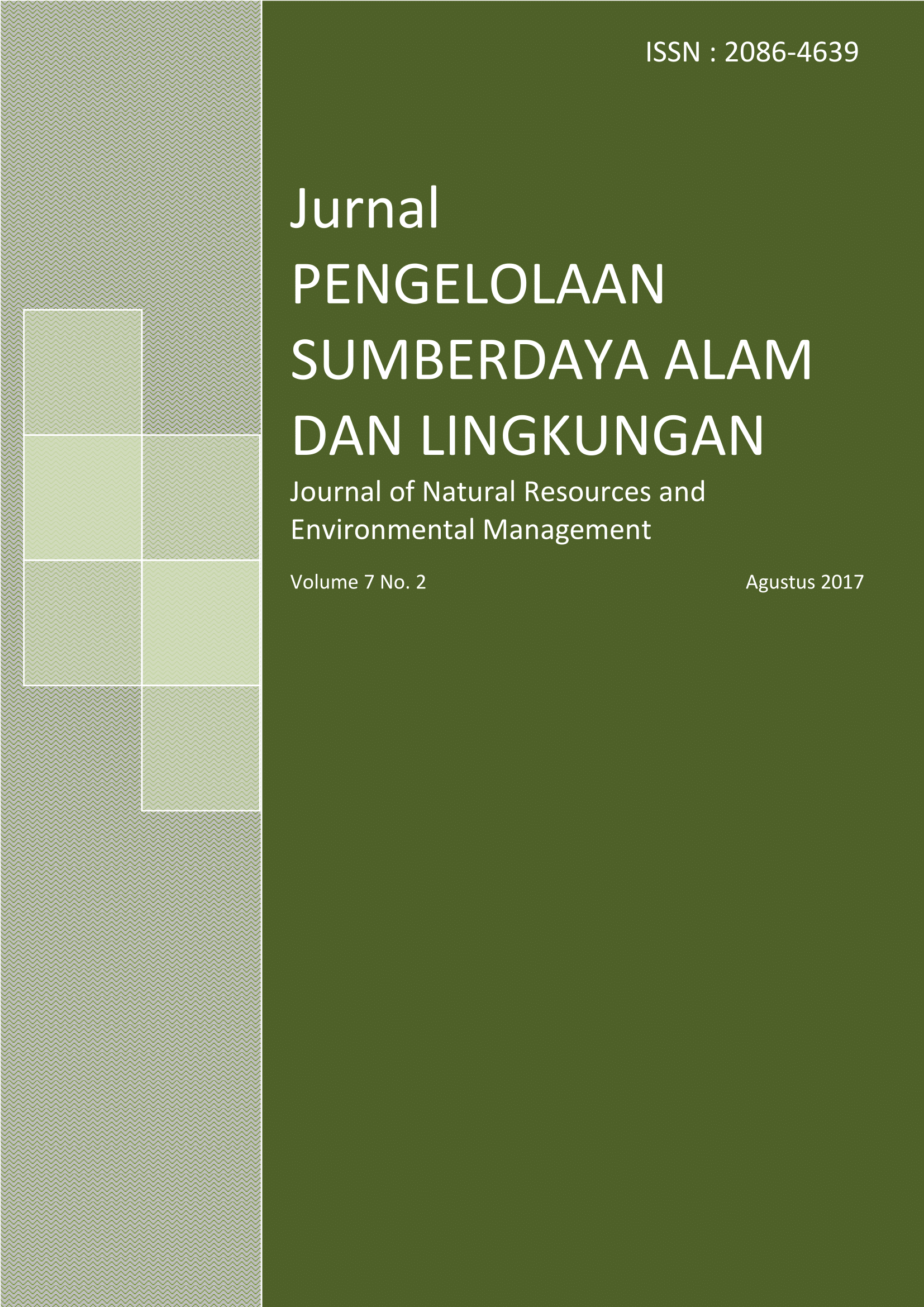ANALISIS PENJALARAN KEKERINGAN METEOROLOGI MENUJU KEKERINGAN HIDROLOGI PADA DAS LARONA
Abstract
References
[BNPB] Badan Nasional PenangSgulangan Bencana, 2015. Perbandingan jumlah kejadian bencana per jenis bencana 1815-2015. http://dibi.bnpb.go.id/DesInventar/dashboard.jsp?countrycode=id&continue=y&lang=ID [1 S
Barker L. J., J. Hannaford, A. Chiverton1, C. Svensson, 2016. From meteorology to hydrological drought using standardize indicator. Hydrol. Earth Syst. Sci. 20, pp. 2483–2505.
Bhavani R., 2013. Comparision of mean and weighted annual rainfall in anantapuram district. International Journal of Innovative Research in Science, Engineering and Technology. 2(7): 2794-2800.
Bachmair, S., K. Stahl, K. Collins, J. Hannaford, M. Acreman, M. Svoboda, C. Knutson, K. H. Smith, N. Wall, B. Fuch, N. D.
Crossman, I. C. Overton, 2016. Drought indicators revisited: the need for a wider con-sideration of environment and society. WIREs Water. 3(4): 516-536.
Dirmeyer P., 2011. Floods and Droughts in a Changing Climate – Now and the Future. http://earthzine.org/?s=+Droughts+[30 Agustus 2015].
Fleig A., 2004. Hydrological drought –A comparative study using daily discharge series from around the world [disertasi]. Univesitas Albert-Ludwigs., Freiburg. http://www.geo.uio.no/edc/downloads/msc_thesis_fleig.pdf [30 Juni 2015].
Folland, C. K., J. Hannaford, J. P. Bloomfield, M. Ken-don, C. Svensson, B. P. Marchant, J. Prior, E. Wallace, 2015. Multiannual droughts in the English Lowlands: a review of their characteristics and climate drivers in the winter half-year. Hydrol. Earth Syst. Sci. 19(5), pp. 2353–2375.
Gustard, A., A. Bullock, J. M. Dixon, 1992. Low flow estimation in the United Kingdom. Institute of Hydrolo-gy, Wallingford, UK. IH Report. 88(108), pp. 1992.
Guttman, N. B., 1999. Accepting the standardized pre-cipitation index: a calculation algorithm. J. Am. Water Resour. As., 35 (2), pp. 311–322.
Hayes, M., M. Svoboda, N. Wall, M. Widhalm, 2011. The Lincoln declaration on drought indices: universal meteorological drought index recommended. B. Am. Meteorol. Soc. 92, pp. 485–488.
Hisdal, H., L. M. Tallaksen, B. Clausen, E. Peters, A. Gustard, 2004. Hydrological Drought Characteristics. Elsevier Science B.V. Amsterdam, the Netherlands. De-velopments in Water Science. 48(5), pp. 139–198.
Kementerian ESDM, 2015. Statistik ketenagalistrikan 2014. Direktorat Jenderal Ketenagalistrikan Kementeri-an Energi dan Sumber Daya Miner-al.https://www.djk.esdm.go.id/images/pdf/statistik-ketenagalistrikan/Statistik%20Ketenagalistrikan%202014%20FINAL.pdf [September 2015].
Lloyd-Hughes, B., 2014. The impracticality of a univer-sal drought definition. Theor. Appl. Climatol. 117, 607–611.
Lloyd-Hughes, B., M. A. Saunders, 2002. A drought climatology for Europe. Int. J. Climatol. 22, pp. 1571–1592.
Lorenzo-Lacruz, J., S. M. Vicente-Serrano, J.C. Gonzá-lez-Hidalgo, J. I. López-Moreno, N. Cortesi, 2013. Hy-drological droughtresponse to meteorological drought in the Iberian Peninsula. Clim. Res., 58, pp. 117–131.
McKee, T. B., N. J. Doesken, J. Kleist, 1993. The Rela-tionship of Drought Frequency and duration to Time Scales, Proceding of the 8th Conference on Applied Cli-matology.
NCAR, 2006. Feasibility study for the augmentation of rain in Sulawesi. Final report to INCO Soroako Indone-sia. National Center for Atmospheric Research, Re-search Application Laboratory USA.
Renggono F., 2011. Pengaruh ENSO terhadap pola angin dan curah hujan di DAS Larona Sulawesi Selatan. Jurnal Sains dan Teknologi Modifikasi Cuaca. 12, pp. 63-68.
Sheffield, J. E. F. Wood, 2011. Drought: Past problems and future scenarios. London: Earthscan.
Stagge, J. H., L. M. Tallaksen, L. Gudmundsson, A. F. Van Loon, K. Stahl, 2015. Candidate distributions for climatological drought indices (SPI and SPEI). Int. J. Climatol. 35, 4027–4040.
Svensson, C., A. Brookshaw, A. Scaife, V. Bell, J. Mac-kay, C. Jackson, J. Hannaford, H. Davies, A. Arribas, S. Stanley, 2015. Long-range forecasts of UK winter hy-drology, Environ. Res. Lett. 10(6), 064006, pp. 1-6.
Svensson, C., J. Hannaford, I. Prosdocimi, 2017. Statis-tical distributions for monthly aggregations of precipita-tion and streamflow in drought indicator applications, Water Resour. Res. 53(2), pp. 999-1018.
Tallaksen L. M., H. A. J. Van Lanen, 2004. Hydrologi-cal drought: Processes and estimation methods for streamflow and groundwater. In: Developments in Wa-ter Science. 48. Amsterdam, theNetherlands: Elsevier Science B.V.
Tauhid Y. I., A. Jon, 2000. Pengamatan Jangka Panjang Kondisi Air Danau Towuti. Jurnal Sains & Teknologi Modifikasi Cuaca. 1(1), pp. 93-100.
Van Loon A. F., G. Lahaa, 2015. Hydrological drought severity explained by climate and catchment characteris-tics. Journal of Hydrology 526 (2015), pp. 3-14.
A. F. Van Loon, 2015. Hydrological drought explained. WIREs Water Wiley Periodicals. 2, pp. 359-392.
Vicente-Serrano, S. M. and J. I. López-Moreno, 2005. Hydrological response to different time scales of clima-tological drought: an evaluation of the Standardized Pre-cipitation Index in a mountainous Mediterranean basin, Hydrol. Earth Syst. Sci. 9, pp. 523–533.
Vicente-Serrano, S. M., J. I. López-Moreno, S. Beguería, J. Lorenzo-Lacruz, C. Azorin-Molina, E. Morán-Tejeda, 2012. Accurate computation of a streamflow drought index, J. Hydrol. Eng. 17, pp. 318–332.
Vidal, J. P., E. Martin, L. Franchistéguy, F. Habets, J. M. Soubeyroux, M. Blanchard, M. Baillon, 2010. Multi-level and multiscale drought reanalysis over France with the Safran-Isba-Modcou hydrometeorological suite. Hydrol. Earth Syst. Sci., 14, pp. 459–478.
[WMO] World Meteorological Organization, 2012. Standardized Precipitation Index User Guide. WMO No 1090.
Wu, H., M. D. Svoboda, M. J. Hayes, D. A. Wilhite, F. Wen, 2007. Appropriate application of the standardized precipitation index in arid locations and dry seasons, Int. J. Climatol. 27, 65–79.
Authors
Authors who publish with this journal agree to the following terms:
- Authors retain copyright and grant the journal right of first publication with the work simultaneously licensed under a Creative Commons Attribution License that allows others to share the work with an acknowledgement of the work's authorship and initial publication in this journal.
- Authors are able to enter into separate, additional contractual arrangements for the non-exclusive distribution of the journal's published version of the work (e.g., post it to an institutional repository or publish it in a book), with an acknowledgement of its initial publication in this journal.
- Authors are permitted and encouraged to post their work online (e.g., in institutional repositories or on their website) prior to and during the submission process, as it can lead to productive exchanges, as well as earlier and greater citation of published work (See The Effect of Open Access).






